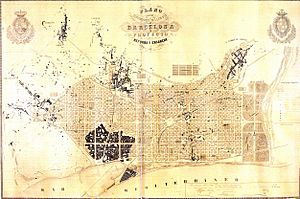Ensanche facts for kids
The word Ensanche (pronounced en-SAHN-che) means "widening" in Spanish. It is a special name for new areas built in Spanish cities around the late 1800s. During this time, many cities grew very fast. More people were moving to cities, and new factories were being built. This period is known as the demographic explosion and the Industrial Revolution.
Because cities were growing so much, old city walls were often taken down. This allowed cities to expand. New neighborhoods were then built using a special plan called a grid plan. This means streets were laid out in a checkerboard pattern.
Contents
Why Cities Expanded: The Ensanche Story
City expansion projects, known as Ensanches, started in Spain around 1860. Two famous plans were for Barcelona, designed by Ildefons Cerdà, and for Madrid, by Carlos María de Castro. These plans were partly inspired by how Paris was changed by Georges-Eugène Haussmann starting in 1852.
The Ensanche projects helped cities grow beyond their old borders. They did this by tearing down city walls. They also changed riverbanks and divided up the rural land just outside the city. This land was called extramuros.
How Ensanches Were Designed
Most Ensanche projects followed ideas from Ildefons Cerdà. His plans included making sure there was plenty of open space. For example, he required open areas in the middle of city blocks. He also planned for whole parks within blocks.
The height of new buildings was also carefully planned. It depended on how wide the street next to the building was. Over time, some of these rules changed. For instance, in Madrid, building sizes were allowed to be larger starting in 1864.
Famous Ensanche Projects
The term Ensanche is used for several important city expansions:
- The Eixample of Barcelona: This is the most famous Ensanche. Eixample is the Catalan word for Ensanche. Ildefons Cerdà planned this large area.
- The Eixample of Valencia: This is another major expansion in the city of Valencia.
- The Eixample in Palma, Mallorca: This project helped Palma, Mallorca, grow.
- The Ensanche Este of Madrid: This eastern expansion of Madrid was part of the Plan Castro. King Philip VI approved this plan in 1860.
- The Ensanche de Bilbao: This expansion happened after the small village of Abando became part of Bilbao.
See also
 In Spanish: Ensanche para niños
In Spanish: Ensanche para niños


